
Around the Agency: June 19, 2019

CBP Strikes Back Against Opioids
Agency leads joint federal, state and local law enforcement operation
By John Davis
According to the Centers for Disease Control and Prevention, opioid abuse kills 115 Americans every day. U.S. Customs and Border Protection has several plans in place to help counter this threat by stopping these deadly, addictive drugs at the border. CBP’s leadership in the Joint Task Force-West coordinated Operation Opioid Counter Strike is one of them. This nationwide collaboration uses many Department of Homeland Security assets – CBP, including Border Patrol, Air and Marine Operations, and Field Operations; Homeland Security Investigations; Immigration and Customs Enforcement; and the U.S. Coast Guard – to decrease the flow of opioids into the country along the Southwest border. The operation looks to break up the criminal organizations that produce and smuggle the drugs in the first place, while also educating those in federal law enforcement about opioid dangers.
“A drug doesn’t make itself. A drug doesn’t smuggle itself. A drug doesn’t sell itself. That’s an organized network doing that,” said Erik Moncayo, recently the chief of staff for the task force headquartered in San Antonio and currently the acting assistant commissioner for international affairs at CBP in Washington, D.C. “We want to do integrated operations going after these criminal networks and organizations that are bringing those drugs across.”
Moncayo said by bringing together a diverse group of law enforcement – federal, state, tribal and local – and tapping into each one’s strengths, the combined effort is more successful than if each just worked on their own, and that success is more easily repeated across the nearly 2,000 miles of the U.S.-Mexico border. “We bring all those folks together to show what does and doesn’t work and see if we can replicate the best practices from east to west,” he said.
Since CBP is the interdiction expert, CBP officers and Border Patrol agents identify high-risk cargo and travelers for further screening, such as X-rays and canine searches. But since manpower can sometimes be short, the task force allows CBP to tap into deeper personnel pools from state and local partners and then use CBP know-how and technology combined with local law enforcement numbers to catch those trying to smuggle drugs.
“The extra boots on the ground from state and local partners allow us to really enhance our operational effectiveness,” Moncayo said, emphasizing the task force doesn’t “own” anyone; it just provides the coordination and tools to get the job done. “We’re trying to be facilitators. We don’t request or re-allocate resources; we try to bring the folks who have those resources to the table to have a discussion and see who can contribute what to this fight.”
The operation is organized into four main corridors: California, Arizona, New Mexico/West Texas and South Texas. These are prime areas for opioids smuggling and other illicit cross-border activities, and each corridor has unique needs and resources. In Arizona, for example, CBP was able to surge its resources a couple of times this summer at two ports of entry by about 50 people. Thanks to the joint task force, CBP was able to draw from federal, state and local law enforcement.

“That included everything from CBP officers, Border Patrol agents, Homeland Security Investigations agents, Arizona Department of Public Safety, and the local county sheriffs’ and police departments,” said Jeff Zadareky, the acting chief of staff for Joint Task Force West-Arizona and a career Border Patrol agent. “All worked on inbound traffic, through the ports of entry or just adjacent to those ports of entry, identifying and interdicting illegal opioid smugglers.”
The efforts paid off with more than 20 arrests just at the state and federal level, and a corresponding number of seizures of narcotics, vehicles and those trying to smuggle in the dangerous drugs.
The decision to surge was made using information from the local CBP field intelligence group, as well as what state and local law enforcement partners were able to tell them. “We have a planning meeting where we talk about what we learned from previous iterations, what the current situation is, and what we can do to best place assets to make interdictions and learn what we’re doing,” Zadareky said.
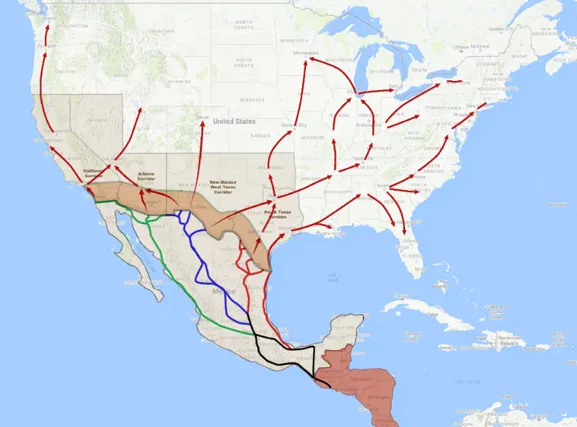
Some of what they learned during those summer surges Joint Task Force-West members will use for a future Operation Opioid Counter Strike. Smugglers, for instance, are going back to some of their old methods, such as false compartments in vehicles and hiding drugs on – and in – their bodies. The difference now seems to be the sheer volume of those trying, requiring the law enforcement surge to shut down those smugglers.
“As a Border Patrol agent who has been doing this for 20 years, I can tell you the intent of the transnational criminal organizations in terms of trying to smuggle these opioids has never been stronger,” Zadareky said. “We’re demonstrating an equal resolve to combat this, by surging those personnel, and meeting these bad guys at the border to stop this.”
Part of the overall strategy is also shutting down the criminal organizations south of the border before they can start the conveyor belt of drugs and human trafficking into the U.S.
“We can work through host countries, our attaché offices or investigative partners to stop that before it crosses our border. We have to come together as a law enforcement network to be able to combat them and all those efforts,” he said. “We have to make it unprofitable,” whether it’s opioids or illegal alien smuggling. “Those criminal organizations prey upon vulnerabilities of those at risk: those using drugs or those just seeking a better way of life, in the U.S. or in a foreign country.”
Moncayo hopes Joint Task Force-West can foster empowerment and teamwork with local partners to meet local needs without taking a heavy hand by telling each area what to do.
“We can’t go at it alone,” he said. “This needs be an all-hands-on-deck effort that requires support, input and collaboration at all levels of the government, our foreign partners and non-governmental partners. That’s what we’re trying to do with Operation Opioid Counter Strike.”
Zadareky has a message to criminal organizations determined to test CBP’s resolve:
“CBP is no less committed to stand watch and be there – whether it’s in the dead of night or in middle of the day in the blazing hot sun – to fight against this surge of illegal activity to protect these countries and communities,” he said. “If you’re involved in this in any way, we’re going to find you, we’re going to apprehend you, and you’re going to face the consequences of your involvement. We owe that to the American public.”

Counter Strike at the Port of San Luis, Arizona. Photo by Scot Osborne

CBP Photo Illustration
Solace for Survivors
By John Davis
A new program is helping CBP do even more for the people left behind when someone in the agency dies – primarily for line of duty deaths – but no one who needs help is turned away. Immediately after a tragedy, CBP works quickly to make sure families are taken care of with access to chaplains, peer support members, and the agency’s honor guard, honoring those who have fallen. The bigger challenge comes long after the memorials are concluded, said Border Patrol Assistant Chief James Cox, CBP’s survivor advocate.
“This program will engage surviving family members when faced with tragedy to ensure they receive the respect, gratitude, and the very best CBP can provide through a complicated process,” he said. “We will also engage with and assist the various CBP components, coordinating with agency officials at the local and national level to ensure surviving family members have access to support, information, and services, closest to where they live, when they need it, and for as long as they need it.”
The new position was officially launched during Police Week in May 2018. The genesis of the program occurred when several surviving family members approached CBP Commissioner Kevin McAleenan to find a better way to handle survivors’ challenges and keep in touch with the agency. The commissioner not only came up with the concept, but he is actively engaged in the effort as it has gotten off the ground. The first survivor advocate was Border Patrol Assistant Chief Michael Cummins, who has moved on to the Tucson, Arizona, sector of Border Patrol.
The program is just getting started, and Cox is engaging with survivors and CBP employees to understand what gaps exist in CBP’s current survivor outreach and benefits delivery programs. He said beyond just getting the word out this new program exists, one of the keys to success will be effective collaboration with the survivors, support personnel, and other CBP officials, especially in areas where CBP can play a bigger role.
Cox stressed the survivor advocate isn’t just one person; the right people at the right places will be identified and receive enhanced training in both benefits delivery assistance and critical incident stress management. Survivors also will be able to reach out to those at the agency’s headquarters to get questions answered beyond local capabilities. Cox envisions a network of local survivor advocates across the country, tapping into the expertise that some employees are already applying at CBP field locations.
“We are also identifying best practices already established within CBP to share across the organization, as well as other entities, such as the Department of Defense,” he said. “I will work with all parties to develop long-term strategies, policies and process changes, correcting the root causes of issues and concerns affecting our surviving families.”
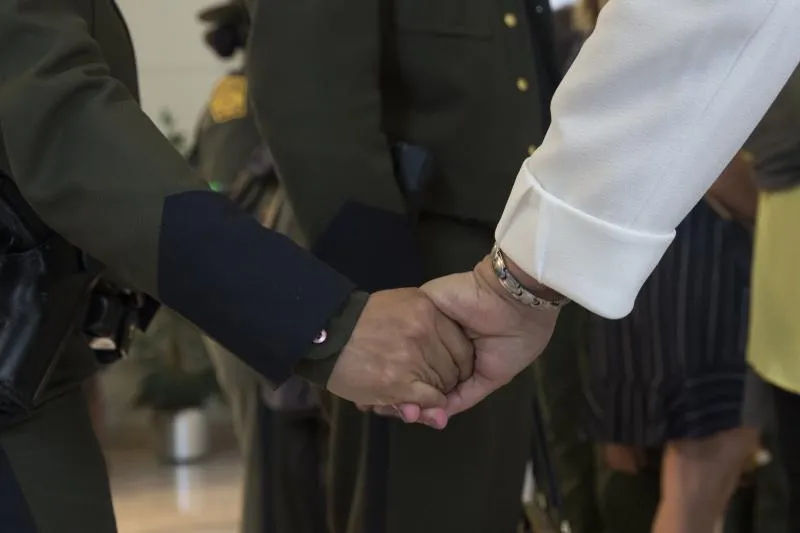
highest level of respect and gratitude. Photo by Donna Burton

El Centro Border Patrol Sector Chief Gloria Chavez, at a May 14 news conference, delivers a statement and welcomes members of the California National Guard. Chief Chavez explained, “Their job is going to be behind the scenes, providing us that critical support that today Border Patrol agents do. Where I need my Border Patrol agents is on the frontline, doing the patrols, doing the interdictions of anything that crosses that border.” Chief Chavez’s statement essentially explained the important support that the men and women of the National Guard provide along the whole southwest border. Photo by Donna Burton
Operation Guardian Support
On April 4, 2018, President Donald Trump issued a memorandum directing the Department of Homeland Security and the Department of Defense to work together to address national security threats along the U.S./Mexico international border. In response, Operation Guardian Support was formed and more than 2,000 National Guard personnel were deployed to the Southwest Border to assist U.S. Customs and Border Protection with executing security missions.
The joint effort works to enhance capabilities that support border security operations as CBP hires and trains Border Patrol agents, builds border wall systems and implements new technology. More specifically, the deployment allows U.S. Border Patrol agents and CBP officers to return to enforcement duties while service members take over non-frontline duties such as aerial surveillance and detection, camera operations, radio communications, fleet management, road maintenance and repairing border infrastructure.
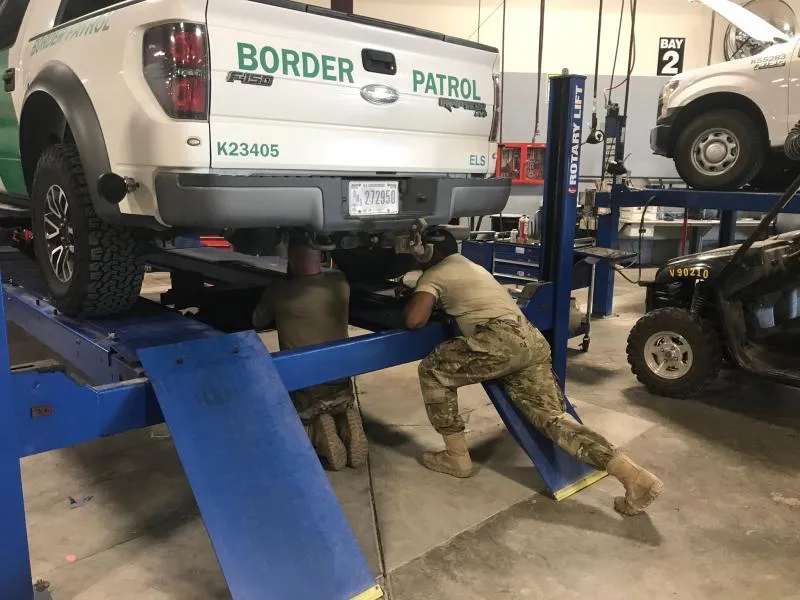
vehicle maintenance facility, which houses hundreds of
fleet vehicles that operate in some of the most extreme
environments and torturous off-road conditions.
National Guard mechanics are up to the task of ensuring
the sector’s fleet vehicles are ready to take Border Patrol
agents to their destinations and back in the most safe
and reliable way. Their daily efforts include frequent
upkeep and maintenance to support extended life of t
he mission critical assets. Photo by Jim Braday
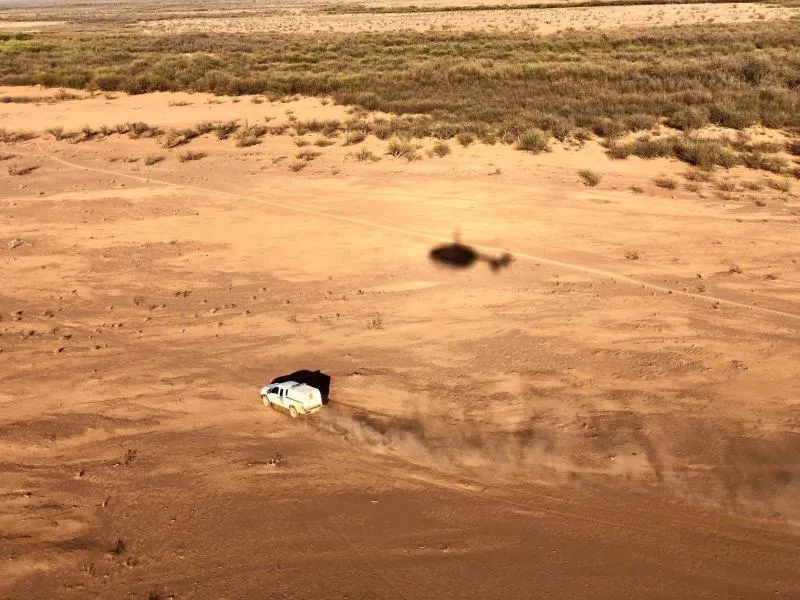
Special Operations Detachment Mobile Response Team,
on patrol in the Tucson Sector west desert area observed
a fire in the open desert approximately 100 miles southwest
of Tucson, Arizona. When the aircraft approached, two
individuals came out of the brush and signaled to the
helicopter. The flight crew guided a Casa Grande Border
Patrol vehicle to the individuals’ location. The two
individuals were determined to be in the United States i
llegally and were processed accordingly. Photo by Zachary Pruitt
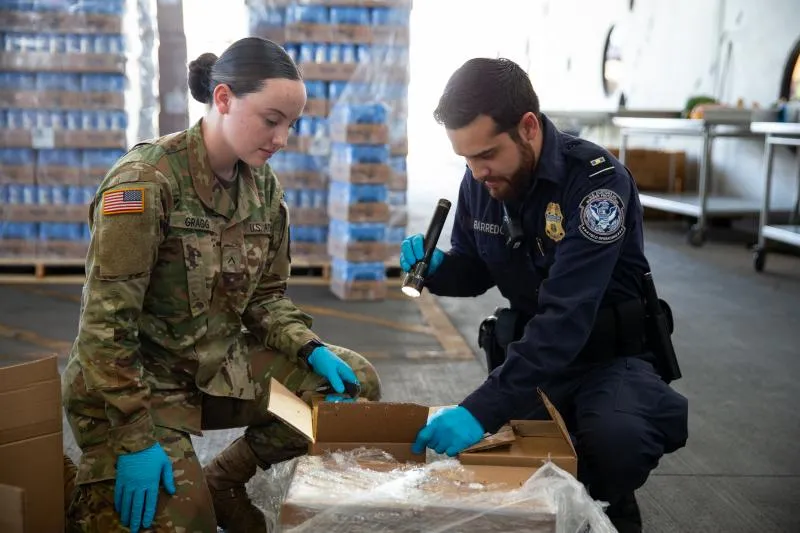
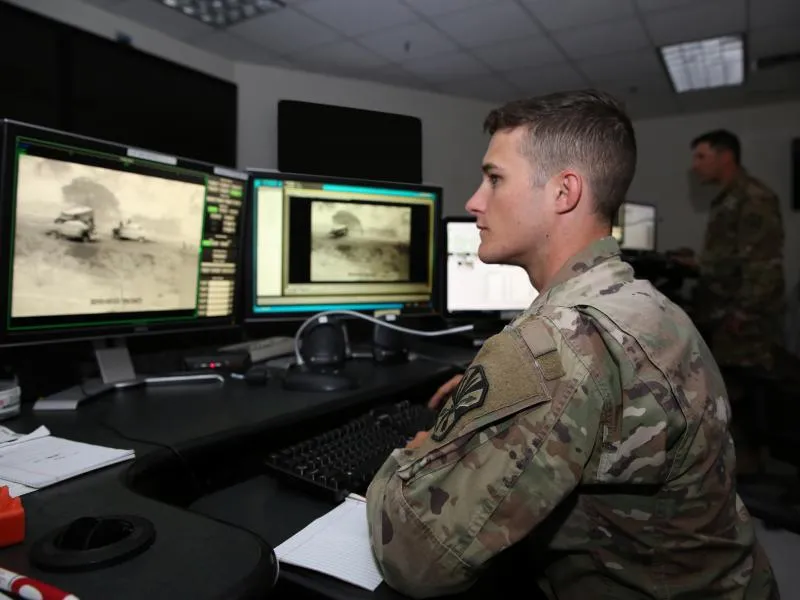
performs camera room duties at U.S. Border Patrol’s
Tucson Station in the Tucson, Arizona sector under
Operation Guardian Support, May 8. CBP Photo
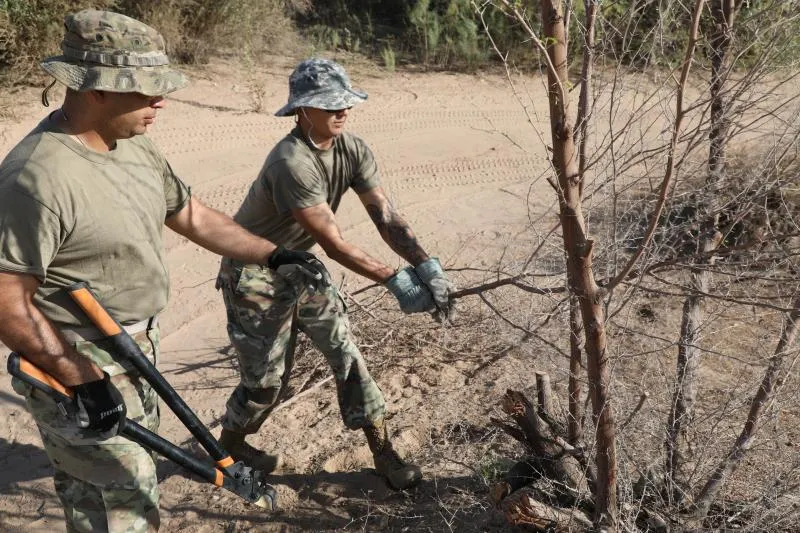
Yuma, Arizona. Troops assigned to the Yuma Sector carry out a number of engineering duties
including facility maintenance and repairs to existing infrastructure such as roads and border walls.
Photo by Staff Sergeant Abram Norwood
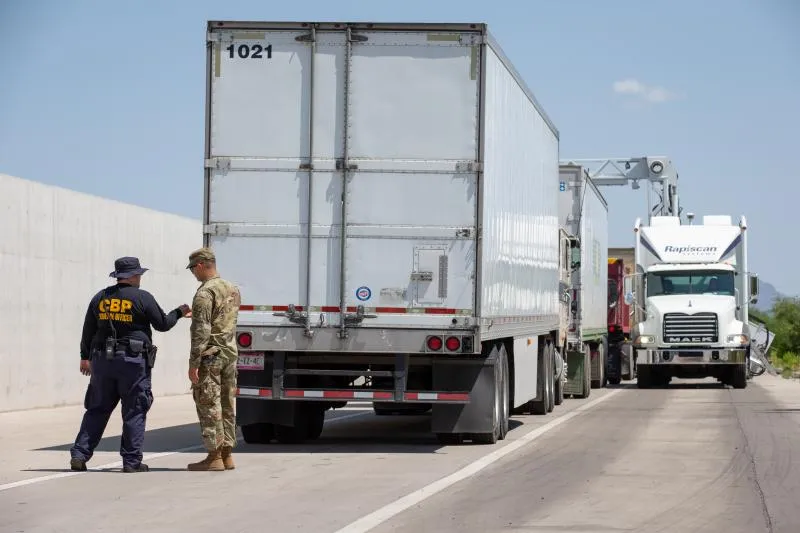
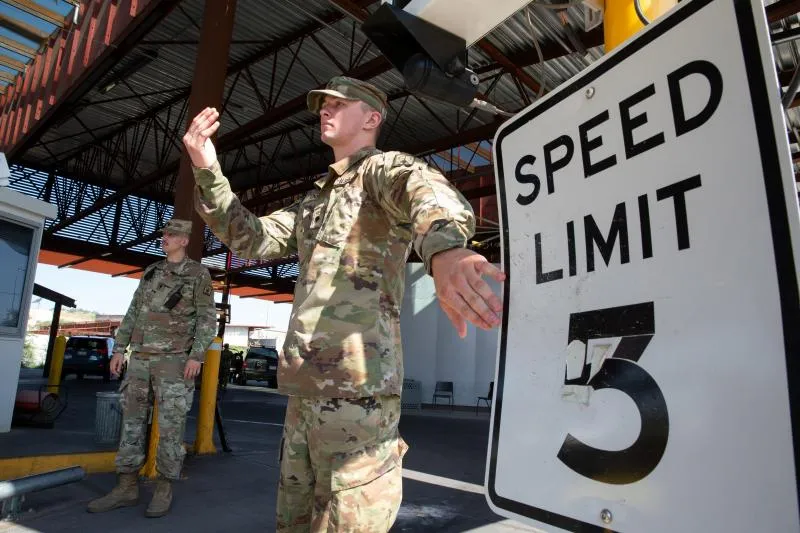
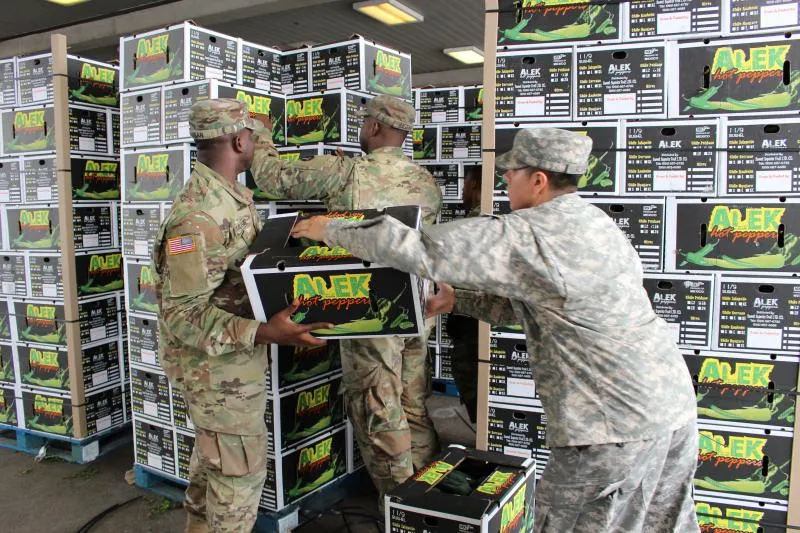
cargo dock by unloading a shipment of hot peppers.
The assistance of the soldiers has expedited the inspection
process of shipments. Photo by Philip Barrera

Agent Gabriel Rojas conducts the systems checklist in preparing the Puma for flight. Notice the protective plate under the nose that safeguards the aircraft during landing.
Taking to the Air
Small, unmanned aircraft extend Border Patrol's reach
By Paul Koscak, Photos by Nicholas Robbs
Searching for solutions to increase its aerial support, the Border Patrol is focusing on aviation’s latest technology—unmanned aircraft. “We had to get creative,” said Assistant Chief Keith Haynes, who manages the project.
Small unmanned aircraft systems, better known as drones, are now among the tools giving Border Patrol agents greater situational awareness and safety. With eyes in the sky, they can patrol the nearby region or simply see over the next ridge to discover threats from afar.
Drones avoid the high cost of using manned helicopters and aircraft and are easy to set up in the field. “They’re agent deployable,” he added. “Trained Border Patrol agents decide how best to deploy them based on each particular mission.”
As force multipliers, the aircraft help make better use of resources and personnel, said Stephen Spencer, assistant chief patrol agent in Tucson. “The benefits are a rapid response to make the judgement call whether to assign assets. If I spend an hour and a half walking to discover a goat tripped a device, I’ve just wasted three hours of my patrol time.”
Test flights have been ongoing for over a year and will continue until September 2019. Based on those results, the Border Patrol plans to select the drones best suited for the field. Currently, three aircraft are being evaluated: the Raven, the Puma and the Indago III. Flown day and night, they were evaluated in the scorching heat of the Southwest desert and in frigid Northeast winters along the Canadian border. While each drone is matched for a different task, they’re all electrically propelled and equipped with powerful cameras and sensors.
The Raven is a mighty midget. Just 3-feet-long with almost a four-and-a-half foot wingspan, the craft weighs just over four pounds. It’s hand launched and can stay aloft up to 90 minutes. Ravens have been used by all the military branches since 2006. They’re fast — up to 50 miles per hour — and agile, an ideal aircraft when time is short.
“It can be carried in a duffle bag and set up and launched in about 15 minutes,” Haynes said.
The Puma packs more punch. Weighing 13 pounds with an over nine-foot wingspan, this drone carries larger cameras and can fly for three hours, perfect for gathering intelligence or orbiting a location. Despite its heft, the aircraft is still remarkably portable. Disassembled, it fits into a carrying case and can be launched in a respectable 30 minutes.
The Indigo III is a platform with four rotors that flies like a helicopter. It’s small, just 10 x 16 inches, weighs three quarters of a pound and can launch in less than three minutes. “It’s when you want to see what’s over the next hill or next ridge or for search and rescue,” Haynes said.
Three agents work as a crew to fly these unmanned aircraft: an agent to set up, launch the aircraft and assist with sensor operation and mission planning; an agent to pilot the drone and control the sensors; and an agent to keep the aircraft in sight. Federal Aviation Administration regulations require drone pilots to keep their aircraft in sight and remain below 400 feet. However, the FAA has given the Border Patrol a waiver to fly up to 1,200 feet.
Border Patrol flight crews are trained in aerodynamics, weather and related FAA regulations—the same subjects studied by all pilots—and then pass a test on the new FAA regulations dealing with remotely controlled aircraft. Border Patrol aviators also use many of the same resources, such as weather briefings and aeronautical charts.
“Deployment is fully compliant with FAA regulations,”emphasized Rio Grande Valley Sector Chief Rodolfo Karisch. With nearby Davis-Monthan Air Force Base, Tucson International Airport and numerous small airports, staying clear of other aircraft is a priority. “We don’t want to put those pilots in any danger,” he said.
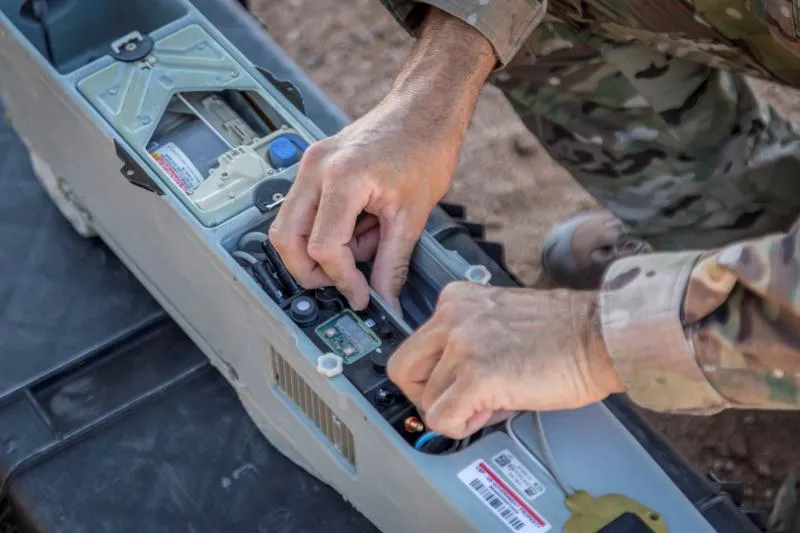
During tests, the aircraft have proven their ability to perform operationally. “We were able to apprehend a group of aliens,” said Karisch. “The group didn’t know the aircraft was overhead. Any time you’re working in an operational zone, there’s a likelihood of targets.”
Karisch said the ability to fly the drones from many locations is a key feature. Tucson Sector has 260 miles of varying terrain and mountain ranges from 4,000 to 9,000 feet and almost 20 percent of that territory has no direct access or roads. The drones allow agents to cover impassable areas. “It’s a game changer,” he said.
Unmanned aircraft are among the latest tools available to agents to accomplish their border security mission, Haynes pointed out. “They’re an essential piece of technology that the Border Patrol will implement to increase situational awareness and officer safety. The capability that this technology provides allows us to achieve those goals and moves us closer to our ultimate goal of operational control of our nation’s borders.”
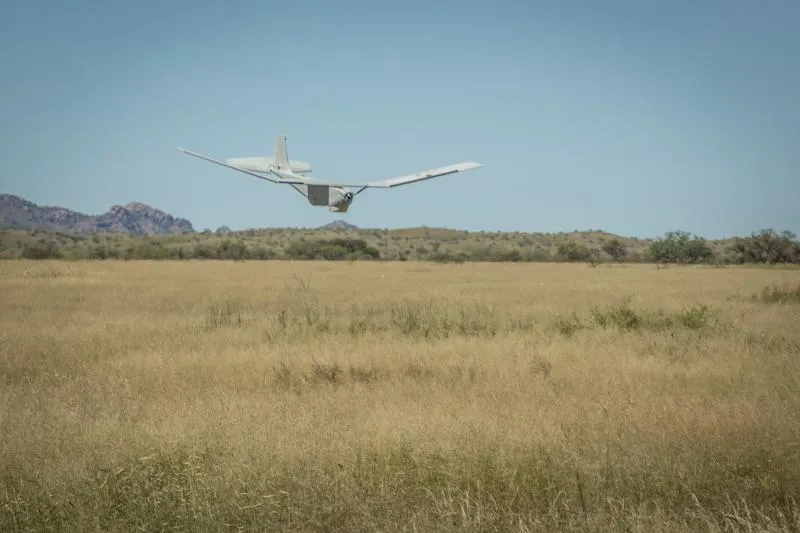

A full-throttled Puma gets a hefty hands-on heave from Border Patrol Agent Paul Grover and takes to the air.
Ready to Launch
Flying Border Patrol aircraft takes preparation and skill
By Paul Koscak, Photos by Nicholas Robbs
Agent Christopher Grubb from the Tucson, Arizona, Sector readies his flight at least 24 hours before taking to the air. He studies his aeronautical chart. He considers airspace classifications, restricted areas, military training routes, nearby airports, towers, power lines — places to avoid. With that, Grubb then spots the best location to fly and draws a circle on the chart outlining the area.
To ensure safety, he notifies the Federal Aviation Administration, which publishes the location to alert other aircraft. The flight is also coordinated with CBP’s Air and Marine Operations Center in Riverside, California, Department of Defense and all interested federal, state and local law enforcement agencies.
Even for a pilot who stays on the ground, it’s the same process for every launch.
Leaving the ground
High in the hills of Sonoita, about 45 minutes east of Tucson, a flight team prepares to launch a Puma, dropping the battery into the nose section and the voltage checked. The wings, made of tough Kevlar, are screwed to the fuselage.
Under a tarp that shields from the blazing sun, the flight crew works its challenge and response checklist, a routine all aviators follow to ensure safety.
“Computer and control unit in sync?” asks Grubb, as he tests his monitor showing wind speed and direction.
“I’m good,” replies Agent Gabriel Rojas.
Grubb enters waypoints into his computer, locations in the sky to guide the aircraft’s flight.
Several yards away, Agent Paul Grover holds the Puma over his head.
“Throttle check,” he yells.
On his hand-held control unit, Rojas turns the knob powering the aircraft’s motor all the way. The propeller instantly becomes a blur, there’s a raspy roar and the air blasts Grover’s face.
Other checks include extending and retracting the camera and moving the rudder and elevator.
“Ready to launch,” Grover calls out as he turns the Puma into the wind. In less than a second, the aircraft revs to full power. With a forceful two-handed heave, he thrusts the Puma forward. The aircraft dips slightly but then climbs.
On Grubb’s monitor, the top of the tarp, parked vehicles and those looking up from below quickly come into view, becoming smaller as altitude increases. A dirt road, gullies and the expansive grassland dotted by desert rapidly appear as the terrain passes through the screen.
From the ground, the Puma is silent. It resembles a hawk circling for its prey. Although the airspeed remains the same, the Puma’s pace over the ground is dramatic. With the wind behind it, the craft rockets down one side of its circle, but inches ahead as it turns upwind on the opposite side.
While flying the aircraft, Rojas zooms the camera in and out, sometimes within a few feet of the ground. The resolution remains sharp. He rotates the camera until it shows the aircraft’s wings. They’re bouncing from the turbulence. Yet the picture is rock steady because the camera’s precision gyro instantly counters each buffet.
“We’ve flown this in greater winds,” Rojas added. At the controls, he increases and decreases the Puma’s speed, climbs and descends the aircraft and switches from autopilot to manual flight.
The Puma has built in protections, Grubb explained. When obstacles are detected, it automatically diverts, “so you can’t fly into a mountain.” If the Puma’s control link is lost or commands cease for a given time, the aircraft will automatically return.
The drone can be commanded to follow wherever the camera is pointing, ideal for tracking targets. To demonstrate, Supervisory Agent Charles Veatch heads off into the field. He circles, zig zags and then hides under a tree. No matter. The camera holds its target and the Puma follows.
When patched into a hand-held device called a team awareness kit, or TAK, these aerial vistas can be linked to almost anywhere, including Border Patrol headquarters, said Veatch, as he viewed the TAK’s monitor.
Dropping from the sky
Landing the Puma amounts to a controlled fall, since the craft has no landing gear. Power is cut and the nose is steeply pitched up. This disrupts the airflow over the wing that creates the lift that keeps any aircraft in the sky. Among aviators, disrupting the airflow is called a stall.
The Puma is brought back from the field and begins circling at about 500 feet, reducing its altitude at each passage. At about 100 feet, as the drone flies over its landing spot, Rojas stalls the aircraft.
Almost instantly, the Puma changes from flying to falling. The nose-high plunge takes about four seconds ending with a thud and the Puma’s wings detaching as designed.
The Puma has a plate under its nose to protect the craft during landings. “It stands up. It’s definitely tough,” said Veatch, describing the craft’s resiliency. But if an operator spots some hazards in the landing site, rocks for example, power can be immediately applied to stop the fall and fly the craft to a better area.


Egyptian border guard officers supplemented their skills through special training at the U.S. Border Patrol Academy in Artesia, New Mexico. More importantly, the exchange advanced CBP’s international network of border security professionals. Photo by Andrea Zortman
Egyptian Border Guard Officers Combine Culture and Training
By Paul Koscak
What started this year as a series of tours to CBP facilities by high-level Egyptian border guard officials grew into an international border guard training program at the U.S. Border Patrol Academy in Artesia, New Mexico. The first-ever class graduated Sept. 19.
The curriculum drew from CBP’s International Affairs Technical Assistance Handbook along with Border Patrol and Department of Defense training courses, resulting in a 60-day program in border security that supplements existing skills and experience.
The course came about after months of negotiations in Cairo between CBP and senior Ministry of Defense members after the Egyptians requested the training.
“This course will not only enhance communication and improve the border security skills of the Egyptian border guard force officers, it establishes a formal blueprint for training the U.S. Border Patrol’s foreign counterparts,” according to Doyle E. Amidon Jr., CBP’s attaché to Egypt. “It lays the foundation of an alumni group consisting of the best and brightest from the global border guard community that will help build relationships, capacity and information sharing for decades.”
Twenty-two mid-level Egyptian border guards made up the class that covered a wide range of subjects, such as developing judgement, weapons fundamentals, pursuits, use of force, physical conditioning and even searching for hidden compartments in vehicles. Six Egyptian border guard generals Amidon escorted observed some of the training.
“The delegation was surprised that we were willing to share so much information about our training program,” he said.
These accomplishments are built upon strong relationships that create trust, Amidon said. Through CBP’s International Visitors Program backed by State Department funding, Amidon has brought several Egyptian delegations to the U.S. to highlight CBP’s best practices and how U.S. agencies coordinate and share intelligence. Having Egyptian border security officials share information with their U.S. counterparts and their neighboring nations increases border security in the region and back at home.
When you take people on the road, you cannot help but develop friendships and trust, Amidon said a senior Egyptian official told him. “In this part of the world, like most parts of the world, everything revolves around trust,” he said.
However, the program isn’t all work. Giving the Egyptians a taste of American culture is just as important as academics and they experienced a little bit of everything, including a county fair and rodeo, lunch at Buffalo Wild Wings restaurant, a high school football game, the beach at Lake State Park and the UFO museum in renowned Roswell, New Mexico.
Future classes will hinge on findings from this first class, said Border Patrol Assistant Chief Robert Shupe. “We’ve never done anything as large in scope,” he said.


